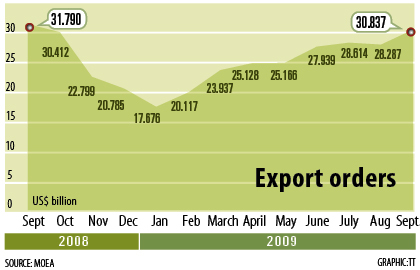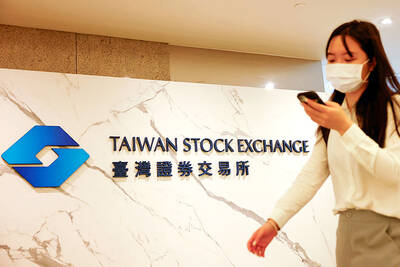The nation’s export orders reached an 11-month high of US$30.84 billion last month, dipping a mere 3 percent from the same period last year as the global economy recovers faster than expected, the Ministry of Economic Affairs said yesterday.
“The [latest] data on export orders is exciting,” because of robust demand from China, Japan and other trading partners in Asia, Huang Ji-shih (黃吉實), director of the ministry’s department of statistics, told a media briefing.
Export orders from Japan and ASEAN nations grew for the first time in almost a year last month, 3.56 percent and 8.79 percent respectively, although orders from the US and Europe remained in negative territory, Huang said.

Export orders from China and Hong Kong increased 9.44 percent year-on-year to US$8.26 billion last month, while those from the US dropped 10.6 percent year-on-year to US$6.61 billion and orders from Europe contracted 13.44 percent to US$5.71 billion, the ministry’s report showed.
Electronic products topped the list at US$7.2 billion, down 0.25 percent from last year, followed by telecommunications and precision products that recorded growth of 2.41 percent and 11.84 percent to US$7.7 billion and US$3.06 billion respectively, the report said.
“The economy will recover faster once electronic export orders outperform those of communications and telecommunications products,” Huang said.
Huang said he expected the data to improve further this month and for the rest of the year.
Cheng Cheng-mount (鄭貞茂), head economist at Citigroup Taiwan Inc, echoed the optimistic sentiment, said the bank may raise its GDP forecast for this year.
“The pace of recovery is much stronger than expected,” Cheng said by telephone. “The improvement is industry-wide and will last through the year.”
The economist predicted export orders would grow an extra 5 percent to 10 percent this quarter, compared with last quarter.
Demand for electronic products is likely to drive the growth, while orders for flat panels were expected to slow, Cheng said.
Meanwhile, the industrial production index, a major economic indicator, returned to positive territory for the first time in 12 months, expanding 1.01 percent from a year ago, a separate report showed.
Huang said the manufacturing industry made the biggest contribution, growing 0.99 percent compared with last year.
The petroleum and chemical materials sectors reported a sharp increase in output at 22.2 percent and 24.61 percent respectively, the data showed. The food industry posted 7.36 percent growth, while basic metals advanced 7.63 percent, the report said.
Johnny Chen (陳擎宏), deputy manager of the economics and industry research department at First Commercial Bank (第一銀行), said the index was likely to climb further in the coming months, spurred by year-end holiday demand from abroad.

ADVANCED: Previously, Taiwanese chip companies were restricted from building overseas fabs with technology less than two generations behind domestic factories Taiwan Semiconductor Manufacturing Co (TSMC, 台積電), a major chip supplier to Nvidia Corp, would no longer be restricted from investing in next-generation 2-nanometer chip production in the US, the Ministry of Economic Affairs said yesterday. However, the ministry added that the world’s biggest contract chipmaker would not be making any reckless decisions, given the weight of its up to US$30 billion investment. To safeguard Taiwan’s chip technology advantages, the government has barred local chipmakers from making chips using more advanced technologies at their overseas factories, in China particularly. Chipmakers were previously only allowed to produce chips using less advanced technologies, specifically

The New Taiwan dollar is on the verge of overtaking the yuan as Asia’s best carry-trade target given its lower risk of interest-rate and currency volatility. A strategy of borrowing the New Taiwan dollar to invest in higher-yielding alternatives has generated the second-highest return over the past month among Asian currencies behind the yuan, based on the Sharpe ratio that measures risk-adjusted relative returns. The New Taiwan dollar may soon replace its Chinese peer as the region’s favored carry trade tool, analysts say, citing Beijing’s efforts to support the yuan that can create wild swings in borrowing costs. In contrast,

VERTICAL INTEGRATION: The US fabless company’s acquisition of the data center manufacturer would not affect market competition, the Fair Trade Commission said The Fair Trade Commission has approved Advanced Micro Devices Inc’s (AMD) bid to fully acquire ZT International Group Inc for US$4.9 billion, saying it would not hamper market competition. As AMD is a fabless company that designs central processing units (CPUs) used in consumer electronics and servers, while ZT is a data center manufacturer, the vertical integration would not affect market competition, the commission said in a statement yesterday. ZT counts hyperscalers such as Microsoft Corp, Amazon.com Inc and Google among its major clients and plays a minor role in deciding the specifications of data centers, given the strong bargaining power of

TARIFF SURGE: The strong performance could be attributed to the growing artificial intelligence device market and mass orders ahead of potential US tariffs, analysts said The combined revenue of companies listed on the Taiwan Stock Exchange and the Taipei Exchange for the whole of last year totaled NT$44.66 trillion (US$1.35 trillion), up 12.8 percent year-on-year and hit a record high, data compiled by investment consulting firm CMoney showed on Saturday. The result came after listed firms reported a 23.92 percent annual increase in combined revenue for last month at NT$4.1 trillion, the second-highest for the month of December on record, and posted a 15.63 percent rise in combined revenue for the December quarter at NT$12.25 billion, the highest quarterly figure ever, the data showed. Analysts attributed the